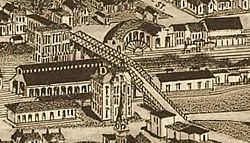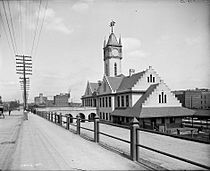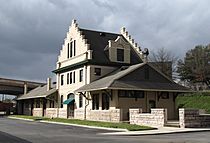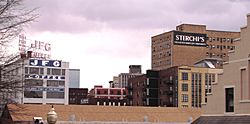Southern Terminal, Knoxville, Tennessee facts for kids
Quick facts for kids |
|
|
Southern Terminal and Warehouse Historic District
|
|
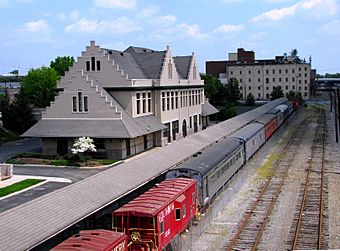
Southern Terminal and tracks, viewed from Gay Street Viaduct
|
|
| Location | Parts of Jackson Avenue, North and South Central Street, Gay Street, State Street, Vine Avenue and Depot Avenue Knoxville, Tennessee |
|---|---|
| Area | approximately 33 acres (13 ha) |
| Built | 1870–1935 |
| Architect | Frank Pierce Milburn; Et al. |
| Architectural style | Chicago, Classical Revival, Romanesque Revival, Renaissance Revival, Italianate, Vernacular Commercial |
| NRHP reference No. | 85002909 |
| Added to NRHP | November 18, 1985 |
The Southern Terminal is an old train station complex in Knoxville, Tennessee, USA. It includes a passenger terminal (where people waited for trains) and an express depot (for packages). These buildings are next to a large railyard (where trains are stored and sorted). The Southern Railway built this complex in 1903.
Both the terminal and depot were designed by a famous train station architect named Frank Pierce Milburn (1868–1926). In 1985, this terminal complex, along with many old warehouses and shops nearby, became part of the Southern Terminal and Warehouse Historic District. This district is listed on the National Register of Historic Places, which means it's an important historical site.
In the 1850s, trains completely changed Knoxville. Before trains, it was a small river town. But with the arrival of railroads like the East Tennessee, Virginia and Georgia Railroad, Knoxville grew into a major trading center in the Southeast. Businesses built many large warehouses along Jackson Avenue. Here, merchants from small towns across East Tennessee would buy goods to sell in their own stores. Later, the Southern Railway took over the ETV&G in 1894. This company then became part of the Norfolk Southern Railway in 1982.
Contents
Where is the Southern Terminal?
The Southern Terminal complex and its railyard are located at the northern edge of downtown Knoxville. They sit in a dip about 15 feet (4.6 m) below the nearby streets. The train tracks run from southwest to northeast. They are roughly parallel to Jackson Avenue on one side and Depot Avenue on the other. The railyard has eleven tracks at its widest point. It stretches from Broadway to Central Street. Gay Street crosses over the railyard on the Gay Street Viaduct.
The main terminal station and express depot are on the north side of the tracks. They are at the corner of Gay Street and Depot Avenue. Many large warehouses from the early 1900s stand between Jackson Avenue and the south side of the tracks. These buildings have loading docks facing the tracks and storefronts facing Jackson Avenue. The Old City is a neighborhood that grew up with the railroad in the late 1800s. It's mainly around the intersection of Central Street and Jackson Avenue.
A Look Back: History of the Railroad
How Railroads First Came to Knoxville
Mountains made it hard for East Tennessee to grow economically in the early 1800s. By the 1830s, Knoxville's leaders saw railroads as a way to connect with other areas. One early idea was the Hiwassee Railroad. It aimed to link Knoxville with a major line in Dalton, Georgia. This would provide a path to the Atlantic Coast. After facing money problems for almost ten years, the Hiwassee became the East Tennessee and Georgia Railroad. Construction started in 1848. The very first train arrived in Knoxville on June 22, 1855.
The area where the Southern Terminal and railyard now stand was once a swamp called the "Flag Pond." People in Knoxville wanted to drain it because they thought it was unhealthy. However, this swampy area was the flattest land in Knoxville. So, the East Tennessee and Georgia Railroad chose it for their Knoxville terminal and railyards. The company built a roundhouse (for turning trains around) and machine shops there. By 1858, another rail line, the East Tennessee and Virginia Railroad, was finished. It connected Knoxville with Bristol.
Railroads During the Civil War
During the American Civil War, the railroad in East Tennessee was very important. It helped supply Confederate soldiers in Virginia and the Deep South. Because of this, Union forces targeted it early in the war. On November 8, 1861, Union supporters destroyed five railroad bridges across East Tennessee. This made Confederate leaders declare martial law (military rule) in the area.
In June 1863, General William P. Sanders led a raid near Knoxville. He destroyed tracks and burned a railroad bridge in Strawberry Plains. In November 1863, Union forces burned the Roundhouse and machine shops. They did this to stop Confederate forces from capturing them.
After the war, William "Parson" Brownlow, who was then governor of Tennessee, took control of the railroad. He claimed the previous president had given the line to the Confederate side. Later, a group led by Charles McClung McGhee bought the East Tennessee and Georgia and East Tennessee and Virginia lines. They combined them to form the East Tennessee, Virginia and Georgia Railroad in 1869.
The East Tennessee, Virginia and Georgia Railroad Grows
The railroad quickly changed Knoxville. The city's population more than doubled from about 2,000 in 1850 to over 4,000 in 1860. After the war, Knoxville's wholesale business grew fast. By the early 1870s, a Knoxville company called Cowan, McClung and Company was Tennessee's most profitable business. The railroad also brought big industries to the city, like the Knoxville Iron Company and Knoxville Woolen Mills. It also helped the Tennessee marble industry grow. By 1882, there were eleven marble quarries in Knox County alone.
Under McGhee and New York financier Richard T. Wilson, the ETV&G expanded quickly. In the 1870s, the company built lines to Kentucky and through the French Broad valley into North Carolina. It also bought lines in Georgia and Alabama. By 1890, the ETV&G controlled 2,500 miles (4,000 km) of tracks in five states. Its tracks reached as far west as Memphis and as far southeast as Brunswick, Georgia, on the Atlantic Coast.
The Southern Railway Era
In 1894, a financier named J. P. Morgan and other investors bought the ETV&G and another railroad. They combined them to create the Southern Railway. The Southern Railway immediately started improving the tracks and trains. They built the Coster Repair Shops, which first employed over 1,000 workers. This led to the development of the Oakwood neighborhood in North Knoxville. In 1925, Southern built the huge John Sevier railyard east of Knoxville. This railyard is still used today by Norfolk Southern to sort trains.
In 1902, Southern hired architect Frank Pierce Milburn to design new train stations across the South. This included the new terminal in Knoxville. The new Knoxville terminal opened in 1903. A similar express depot opened in 1907. A year after the passenger depot opened, the New Market train wreck happened nearby. It killed 56 passengers. A Knoxville street musician named Charlie Oaks, who played at the terminal, wrote a song about the wreck. In 1924, Oaks became one of the first musicians to record what we now call country music.
At its busiest, the Southern Terminal served 26 passenger trains every day. But as cars and buses became more popular, fewer people traveled by train. After World War II, the Southern Railway ran eight express trains and twelve local lines out of Knoxville. By 1956, the local lines were gone. Most express trains were stopped by the late 1960s. The last regular passenger train left the Southern Terminal on August 12, 1970.
Southern Terminal and Warehouse Historic District
The Southern Terminal and Warehouse Historic District was added to the National Register of Historic Places in 1985. It was recognized for its late 1800s and early 1900s commercial buildings. It was also important for its role in Knoxville's railroad trade and wholesale business. The district includes the Southern Terminal complex, all of West Jackson Avenue, and parts of other streets. It also includes the former White Lily plant on Depot. Some buildings in the district, like Sullivan's Saloon, were already listed on the Register in the 1970s.
Originally, there were 75 important buildings and structures in the Southern Terminal district. Some of these are no longer standing. The old Gay Street Viaduct was included, but it was torn down and replaced in 2005. Other missing buildings include an old freight depot and some warehouses. In 2004, the district was expanded to include the Southeastern Glass Building.
Southern Passenger Terminal and Express Depot Buildings
The passenger terminal and express depot were both designed in a similar style. They have a "Classical Revival" influence, meaning they look a bit like old Greek or Roman buildings. They are known for their unique stepped gabled roofs. The terminal building has two and a half stories. The lower level used to have dining rooms, baggage check, and mail rooms. The upper level had ticketing and waiting rooms. A bridge connects the upper level to Depot Avenue. The building originally had a clock tower, but it was removed in 1945 due to structural problems.
The express depot has a two-and-a-half-story central part with two one-story wings on each side. The central part looks similar to the passenger terminal. Part of the depot's east wing was removed to create an open courtyard. Today, the main terminal building is used for offices. The express depot is used as a meeting place for events.
Patrick Sullivan's Saloon Building
Sullivan's Saloon (100 E. Jackson) is a two-story building built in 1888. It has a Romanesque Revival style with some Queen Anne elements. Patrick Sullivan (1841–1925), who owned the saloon, built it. He came from Ireland in the 1850s and opened his saloon after the Civil War. The saloon first operated out of a wooden building. It was later replaced by this fancy brick structure. The building was a saloon until 1907, when it had to close because of citywide Prohibition (a ban on alcohol). The building was home to Patrick Sullivan's Steakhouse and Saloon from 1988 to 2011. It has been called the "best example of a downtown saloon still standing in the southeastern United States." The building was sold in 2014 and has been renovated.
Other Interesting Buildings Nearby
- 200 East Jackson: This is a two-story warehouse building. It was built around 1910.
- 121-123 West Jackson, also called the Carhart Building: This is a three-and-a-half-story brick warehouse. It has a Romanesque Revival style front. It was built around 1900. The Carhart Building was designed by the Baumann Brothers and named after a grocery wholesaler. Today, 121 West Jackson has a shop called Crush, which sells retro rock fashion.
- 120-122 West Jackson: A five-story brick warehouse built around 1900.
- 124 West Jackson: Another five-story brick warehouse with a Romanesque Revival front, built around 1900. It might have been used by a clothing wholesaler called Powers, Little and Company.
- 125 West Jackson: A three-and-a-half-story brick building with a Classical Revival style front, built around 1890. In the 1890s, two wholesale grocery businesses were here. One of its current tenants is Remedy Coffee.
- JFG Flats (200 West Jackson): This is a six-story concrete building built in 1920. The JFG Coffee Company used it for many decades. The company's large neon sign is still on top of the building. It now has apartments.
- 203 West Jackson: A one-story brick freight depot, built around 1870. It was greatly renovated in the late 1990s.
- McClung Warehouses (501-525 West Jackson): These were built for the wholesale company C.M. McClung and Company. Some of the buildings were constructed between 1893 and 1927. Several of these warehouses burned in 2007 and 2014.
- The Emporium Building (102-106 South Gay): A three-story warehouse built in 1898. It has a Renaissance Revival style. The Sterchi Brothers Company, a furniture wholesaler, built it.
- Sterchi Lofts (114-116 South Gay): A ten-story warehouse and office building built in 1925. It was designed by architect R. F. Graf. The Sterchi Brothers furniture company used it as a warehouse until the late 1900s. Now, it has apartments.
- Commerce Building (120-126 South Gay): A four-story building with an Italianate style, built in the early 1890s.
- White Lily Foods Company building (106 Depot): A four-story brick factory built in 1885. White Lily operated here until 2008. The building has been turned into apartments that opened in 2015.
- The 100 blocks of North and South Central have almost two dozen commercial buildings. They were built between 1880 and 1925 and are one to three stories tall. Most of these buildings were renovated in the 1980s and 1990s. This area was then renamed the "Old City."




